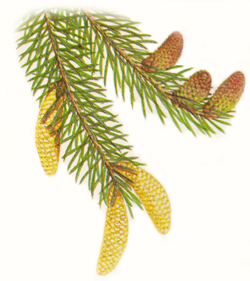|
Sitka spruce belongs to the genus Picea and is a member of the pine family (Pinaceae).
Sitka spruce (Picea sitchensis) is a conifer tree growing to over 60m and flowering in May.
Lifespan: In its native range Sitka spruce is known to live for over 700 years.
Characteristics
Bark on young trees is dark grey and flaking, becoming purplish-grey with coarse lifting scales. Mature tree bark is purplish-grey and cracked into square-shaped lifting plates. The base of the trunk is often buttressed. Upper branches ascending, lower branches rise and arch widely over and down. Branchlets are dense and hanging. Twigs are white becoming pale brown, grooved, knobbly and never hairy. Buds are ovoid, blunt, purplish-brown and resinous.
Spruces all have a woody peg at the base of every needle which is a useful identification aid. Needles are 2–3cm, slender, sharply pointed, hard and stiff, green above with two bright blue-white bands beneath. Needles grow straight out flat from the shoot with the upper needles pressed down close to the shoot along its centre. From a distance the foliage appears blue-grey.
Sitka spruce is monoecious: both male and female flowers are found on the same tree. Male flowers are ovoid, blunt and pale yellow. Female flowers are red, upright and oval, often crowded toward the top of the tree. Sitka spruce is wind pollinated.
The cones (5–8cm) are distinctive, cylindrical, pale green in summer but ripening into nearly white, pale creamy-brown cones; each one of the thin, papery scales has a crinkly, toothed edge. The seeds are small and winged.
|













